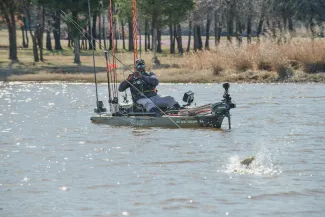
Oklahoma is a great place to fish for all kinds of species, but it’s safe to say bass fishing has a special place in the hearts of anglers, and with plenty of reason. The fast-paced action of a hard-fighting black bass makes it just plain fun to catch.
The catch-and-release of largemouth and smallmouth bass is deeply rooted in fishing culture across the nation. In fact, keeping bass has become somewhat taboo. As a result of the often self-imposed practice, catch-and-release has been touted as one of the most successful fisheries management tools in recent history. So it can be difficult to accept, especially by bass anglers, that the practice of catch-and-release has possibly gone too far.
Oklahoma's general fishing regulations allow anglers to possess six smallmouth or largemouth bass over 14 inches. In other words, anglers can only keep bass over 14 inches. But on average, 70 percent of the largemouth bass in Oklahoma lakes are less than 14 inches, limiting the opportunity to keep bass. This is concerning for Wildlife Department fisheries biologists, as their main goals are to not only manage the state's fisheries resources so that natural reproduction will sustain populations, but also manage these resources to create as many quality angling opportunities as possible.
In Oklahoma, the largemouth bass is among the most-sought-after fish, and has been for decades. To address the growing popularity of bass fishing, the Wildlife Department developed a statewide black bass management plan in 1991. Long-range management goals with specific objectives were set, including the eventual implementation of the 14-inch minimum length limit on smallmouth and largemouth bass. At that time, less than 10 percent of bass fishing lakes sampled were considered to be a “quality” bass fishery. The regulation was heavily supported by anglers, many of whom had been prioritizing catch-and-release since it became a cultural movement in the 1980s.
Since then, Oklahoma has become a top destination for bass fishing. So popular in fact, B.A.S.S. selected Oklahoma as the host state in 2013 and 2016 for the Bassmaster Classic at Grand Lake O' the Cherokees in northeastern Oklahoma. But fisheries biologists are taking note of slowing growth rates and skewed size structures of our black bass populations.
“The popularity of largemouth bass is well-deserved considering the number of water bodies available for recreational or tournament bass fishing throughout the state," said Cliff Sager, Senior Fisheries Biologist with the Oklahoma Department of Wildlife Conservation. "And, while much has been done by the Wildlife Department to promote fishing, including bass fishing, in recent years, the adjustment of management strategies aimed at influencing quality bass fisheries has been limited. Currently, we are considering ways in which bass management in Oklahoma could be improved."
Biologists’ management plans are often dictated by the concept of carrying capacity. Carrying capacity is the total biomass of fish that a waterbody can support. One way to relate to the concept of carrying capacity is to think about cattle on a farm. If a farmer has 20 cattle on a 40-acre farm, the farmer doesn’t have enough food and space to run additional cattle. Too many cows per acre leads to competition for food, space and shelter. Over time the condition of the herd deteriorates. One option woud be to supplement with more food, but the better option is to thin the herd and allow the pasture, or habitat, to recover.
The catch-and-release concept gained support when black bass harvest was at a high; we’ve all seen pictures of our dad or grandpa holding a big stringer of bass. Now, the pendulum has swung to the other side, and black bass harvest is extremely low. While catch-and-release may have benefits under a narrow set of conditions, harvest of smaller, more abundant bass is needed to sustain quality black bass fisheries. In fact, harvest is one of the key components in creating and maintaining a bass fishery.
Oklahoma has a vast array of public waters, and managing their individual fish populations requires foresight coupled with sound biological background. Fisheries managers must look ahead several years since it takes that long for fish to mature to a spawning age or grow large enough to satisfy the angling public’s needs. Length limits, daily limits, stocking and habitat improvements are all tools that biologists have available to influence and manage populations. How those tools, or combinations of tools, are used is key to providing quality angling opportunities for as many sportsmen and sportswomen as possible.
To maintain focused oversight of these species, the Wildlife Department established a Centrarchid Committee composed of 10 fisheries biologists with specialties ranging from reservoirs to hatcheries. Together, they have more than 160 years of experience in fisheries management. The Centrarchidae (sunfish) are a family of North American native freshwater fish and include several game fish familiar to anglers, including smallmouth and largemouth bass, bluegill and crappie. Biologists will continue to survey and monitor population trends and develop management practices that better meet the needs and expectations of Oklahoma anglers.
-Kelly Adams is the Communication Section supervisor for the Wildlife Department.